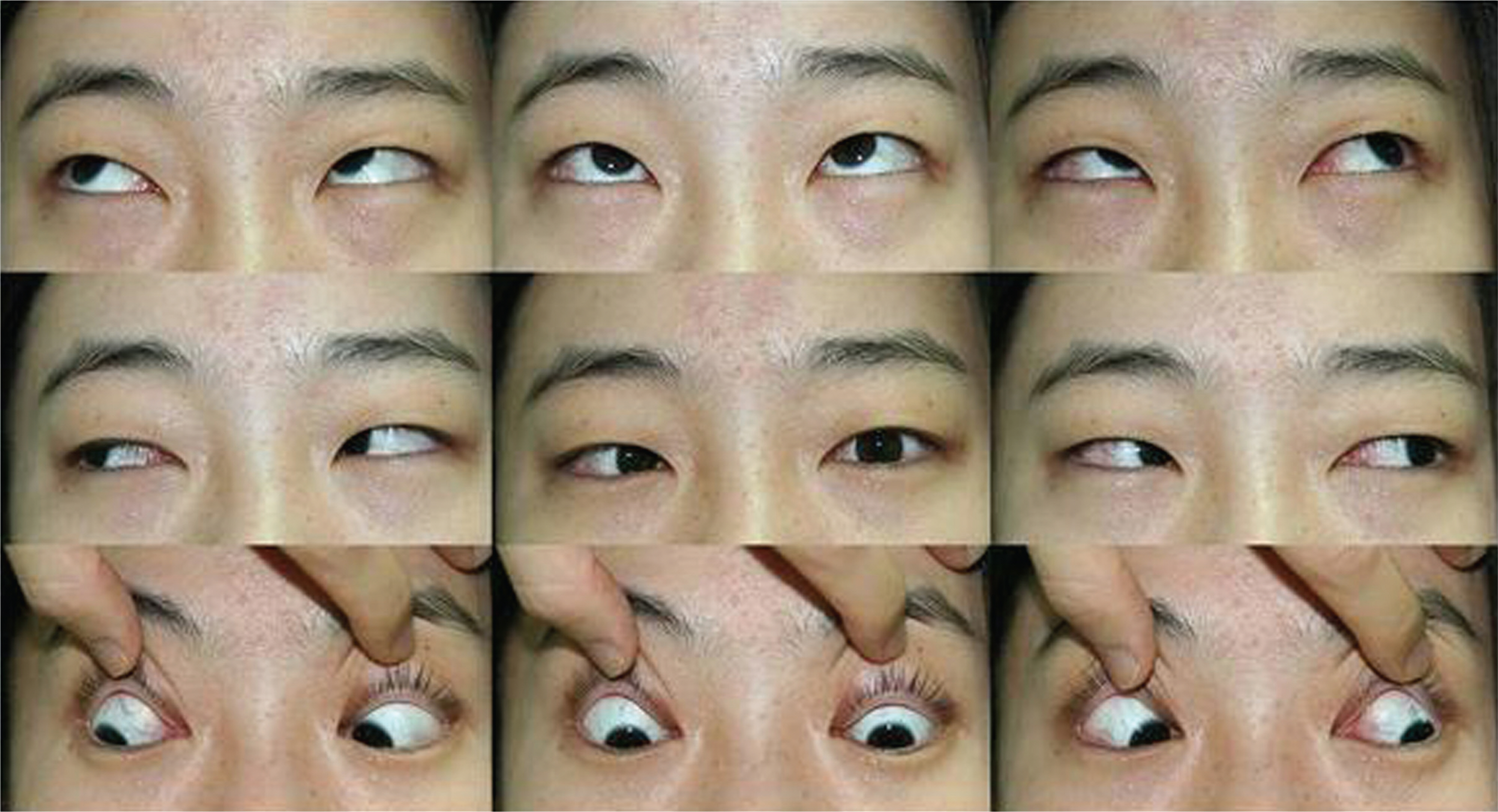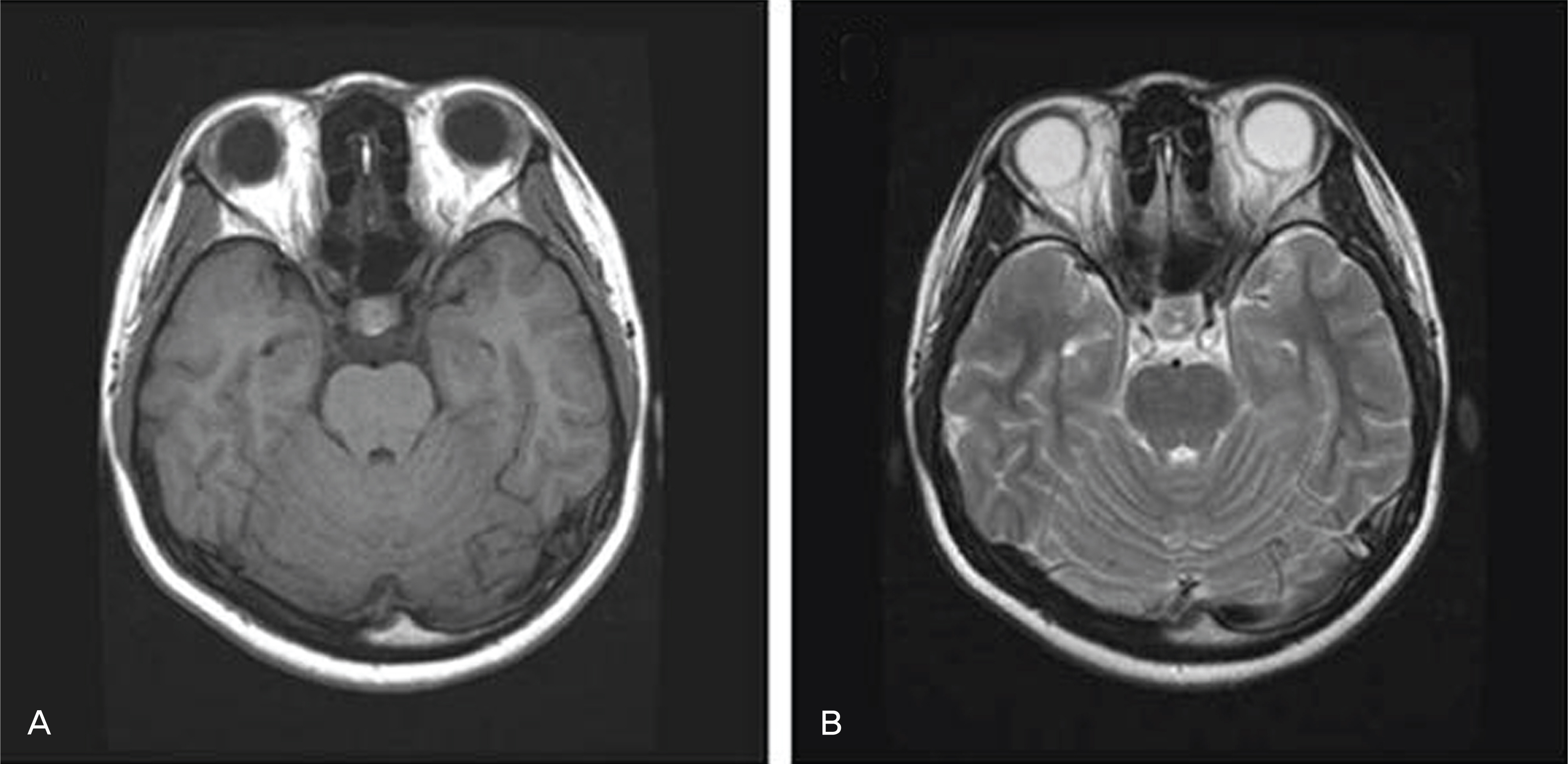J Korean Ophthalmol Soc.
2009 May;50(5):804-807. 10.3341/jkos.2009.50.5.804.
A Case of Convergence Spasm After Head Trauma
- Affiliations
-
- 1Department of Ophthalmology, College of Medicine, Chungnam National University, Daejeon, Korea.sblee@cnu.ac.kr
- 2Department of Ophthalmology, Chungnam National University Research Institute for Medical Sciences, Daejeon, Korea.
- KMID: 2212329
- DOI: http://doi.org/10.3341/jkos.2009.50.5.804
Abstract
-
PURPOSE:We report a case of convergence spasm that occurred after head trauma.
CASE SUMMARY
A 18-year-old female presented with intermittent diplopia and decreased vision shortly after head trauma. Her past medical history was non-specific, except myopia in the left eye. On the initial examination, her uncorrected visual acuity and was variable (0.1~1.2 in the right eye, 0.05~0.1 in the left), but the corrected visual acuity was 1.2 in both eyes. Manifested refraction was also variable (-0.50~-5.50 diopters (D) in the right eye, -4.50~-6.50D in the left eye). Cycloplegic refraction was -0.50D in the right eye, and -4.50D in the left eye. The patient showed a variable esotropia (4~16 prism diopters (PD) at distance, 4~30PD at near). There was no limitation on abduction. There was no abnormality in the brain MRI. Five months after the initial visit, diplopia and blurred vision persisted.
Keyword
MeSH Terms
Figure
Reference
-
References
1. Rutstein RP, Daum KM, Amos JF. Accommodative spasm: a study of 17 cases. J Am Optom Assoc. 1988; 59:527–38.2. Goldstein JH, Schneekloth BB. Spasm of the near reflex: a spectrum of anomalies. Surv Ophthalmol. 1996; 40:269–78.
Article3. Sloane AE, Kraut JA. Spasm of accommodation. Doc Ophthalmol. 1973; 34:365–9.
Article4. Bohlmann BJ, France TD. Persistent accommodative spasm nine years after head trauma. J Clin Neuroophthalmol. 1987; 7:129–34.5. Monteiro ML, Curi AL, Pereira A, et al. Persistent accommodative spasm after severe head trauma. Br J Ophthalmol. 2003; 87:243–4.
Article6. Chan RV, Trobe JD. Spasm of accommodation associated with closed head trauma. J Neuroophthalmol. 2002; 22:15–7.
Article7. Knapp C, Sachdev A, Gottlob I. Spasm of the near reflex associated with head injury. Strabismus. 2002; 10:1–4.
Article8. Ohtsuka K, Maekawa H, Takeda M, et al. Accommodation and convergence insufficiency with left middle cerebral artery occlusion. Am J Ophthalmol. 1988; 106:60–4.
Article9. Romano PE, Stark WJ. Pseudomyopia as a presenting sign in ocular myasthenia gravis. Am J Ophthalmol. 1973; 75:872–5.
Article10. Cooper J, Pollak GJ, Ciuffreda KJ, et al. Accommodative and vergence findings in ocular myasthenia: a case analysis. J Neuroophthalmol. 2000; 20:5–11.11. Blain P, Paques M, Massin P, et al. Acute transient myopia induced by indapamide. Am J Ophthalmol. 2000; 129:538–40.
Article12. Moster ML, Hoenig EM. Spasm of the near reflex associated with metabolic encephalopathy. Neurology. 1989; 39:150.
Article13. Yang YR, Koh JW, Choi NY, Park SC. A study of patients with spasm of the near reflex. J Korean Ophthalmol Soc. 2006; 47:1630–7.
- Full Text Links
- Actions
-
Cited
- CITED
-
- Close
- Share
- Similar articles
-
- A Case of Hysterical Convergence Spasm
- A Study of Patients with Spasm of the Near Reflex
- Methods and Effect of Management of Patients with Convergence Spasm and Aquired Pseudomyopia
- Accommodation and Convergence, Anomalies of Convergence
- Vestibular Paroxysmia and Hemifacial Spasm by Vascular Compression



